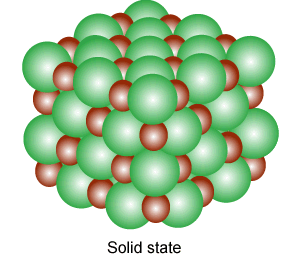A diatomic molecule $X_{2}$ has a body-centred cubic (bcc) structure with a cell edge of $300\, pm$. The density of the molecule is $6.17 \,g \,cm ^{-3}$. The number of molecules present in $200\, g$ of $X _{2}$ is (Avogadro constant $\left.\left( N _{ A }\right)=6 \times 10^{23} \,mol ^{-1}\right)$
- $8\, N _{ A }$
- $40\, N _{ A }$
- $4 \,N _{ A }$
- $2 \,N _{ A }$
The Correct Option is C
Solution and Explanation
$ \Rightarrow 6.17=\frac{2 \times \frac{ M }{ N _{ A }}}{\left(3 \times 10^{-8} cm \right)^{3}}$
$\Rightarrow M \simeq 50 gm / mol$
No $=\frac{ w }{ M } \times N _{ A }=\frac{200}{50} \times N _{ A }=4 N _{ A }$
Top Questions on The solid state
- A metal crystallizes in simple cubic lattice. The volume of one unit cell is \( 6.4 \times 10^{-7} \, \text{pm}^3 \). What is the radius of the metal atom in pm?
- AP EAPCET - 2025
- Chemistry
- The solid state
- A metal crystallises in two cubic phases, fcc and bcc with edge lengths 3.5 Å and 3 Å respectively. The ratio of densities of fcc and bcc is approximately
- TS EAMCET - 2025
- Chemistry
- The solid state
- How many kinds of Bravais lattice are possible in a crystal?
- Bihar Board XII - 2025
- Chemistry
- The solid state
- The percentage of free space in a body-centred cubic unit cell is
- Bihar Board XII - 2025
- Chemistry
- The solid state
- The number of atoms present in body-centred cubic unit cell is
- Bihar Board XII - 2025
- Chemistry
- The solid state
Questions Asked in JEE Main exam
The metal ions that have the calculated spin only magnetic moment value of 4.9 B.M. are
A. $ Cr^{2+} $
B. $ Fe^{2+} $
C. $ Fe^{3+} $
D. $ Co^{2+} $
E. $ Mn^{2+} $
Choose the correct answer from the options given below- JEE Main - 2025
- Coordination chemistry
Which of the following circuits has the same output as that of the given circuit?

- JEE Main - 2025
- Logic gates
- The kinetic energy of translation of the molecules in 50 g of CO\(_2\) gas at 17°C is:
- JEE Main - 2025
- The Kinetic Theory of Gases
- Using the principal values of the inverse trigonometric functions the sum of the maximum and the minimum values of \(16((sec^{-1}x)^{2}+(cosec^{-1}x)^{2})\) is:
- JEE Main - 2025
- Inverse Trigonometric Functions
Consider the following sequence of reactions :

Molar mass of the product formed (A) is ______ g mol\(^{-1}\).- JEE Main - 2025
- Organic Chemistry
Concepts Used:
Solid State
Solids are substances that are featured by a definite shape, volume, and high density. In the solid-state, the composed particles are arranged in several manners. Solid-state, in simple terms, means "no moving parts." Thus solid-state electronic devices are the ones inclusive of solid components that don’t change their position. Solid is a state of matter where the composed particles are arranged close to each other. The composed particles can be either atoms, molecules, or ions.

Types of Solids:
Based on the nature of the order that is present in the arrangement of their constituent particles solids can be divided into two types;
- Amorphous solids behave the same as super cool liquids due to the arrangement of constituent particles in short-range order. They are isotropic and have a broad melting point (range is about greater than 5°C).
- Crystalline solids have a fixed shape and the constituent particles are arranged in a long-range order.